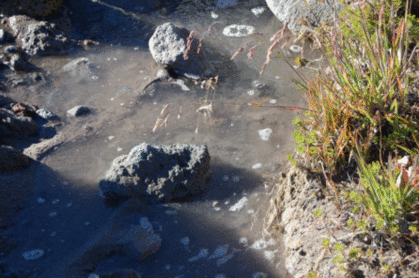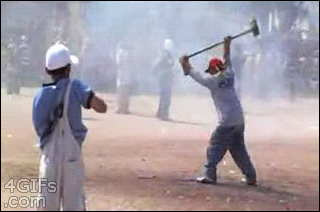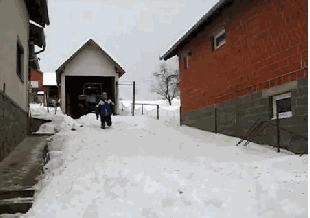Jessica Ball, AKA Tuff Cookie, AKA the author of Magma Cum Laude, earlier asked a question to which I can relate: namely, how does one approach teaching a (potentially) controversial subject?
First, you want to make sure you know your stuff. Students can smell instructor uncertainty. Definately familiarize yourself as well ahead of time as you can with the textual material your students will be using. I've seen a decent student in science ed get chewed up and spat out because he was really not qualified to TA the subject matter- he didn't have to take that position, he had other options, but thought it would be "fun." I was teaching a different section of the same course, and in some ways was a bit better prepared- though not academically. The difference was I had an interest in the material, I had done plenty of reading about it on my own, and I made sure I understood it better than the students were going to be expected to. I can honestly say the same would be true on the topic of climate change- I've had little formal classwork on the subject, but it's very interesting to me, and I've done a lot of independent reading on it. Below is a list of climate and related blogs/sites I follow in RSS, and a brief sketch of the value I get from each.
Arctic Sea Ice News & Analysis- This may seem like a very esoteric topic, but Arctic sea ice appears to be the most sensitive component of out planet with respect to climate change. It can be viewed as the "canary in the coal mine" or "bellwether" for the rest of the planet. And this is the go-to site for data tracking daily to long term trends in the ice pack up top. Their monthly, seasonal, and annual summaries are don't miss. And their coverage of the approach to least extent in mid-September is stunningly good and gripping.
Arctic Sea Ice Blog- This guy makes no pretense of being an "expert" (do take a moment to read the disclaimer) but he's clearly no slouch, and clearly finds the topic fascinating. He's also very good at finding important statistics and data.
Real Climate- Gotta be honest, this one is generally a bit too wonky for me. I generally skim the posts enough to get the general gist, then skip the gory details. Still, it's a good one for keeping abreast of current news.
Open Mind- One of my favorites of the bunch. There are times when the detailed approach to stats is more than I want to wade through, but generally readable. In particular, Tamino goes out of his way to bluntly take down nonsense from deniers, with Anthony Watts front and center (See "Dishonorable Mention," below).
Jeff Master's Wunderblog- Not a "climate blog" per se, but weather-focused. I think Masters would be among the first to point out meteorology and climate science are different (if related) disciplines. However, news related to climatology pops up there regularly- such as today's post on billion-plus dollar disasters and top ten meteorological events of 2012.
Dishonorable Mention: Watts Up With That? Not recommended as regular reading, but you should know what the deniers are up to... and Anthony Watts is probably the highest-profile denier out there. I often find his posts through links from take-downs, and there is a certain pleasure in reading one and spotting the fallacy (or fallacies) on one's own. The errors take on a few standard forms: misrepresentation or faulty selection of data, misunderstanding or faulty implementation of statistical methods, conflating adjustments to data (which have been debated, discussed, and finally accepted among a large community of qualified scientists as providing better accuracy) as "fudging" or "making up" data and so on. And when all else fails, fall back on ad hominem attack, which in some circles is apparently a valid debating tactic.
Continuing, it also helps to have enough confidence to flatly state "I don't know,"
when that's accurate. And if the question is important enough to merit
it, follow though and find out- then share the answer with the class and/or questioner as seems appropriate. On the other hand, do not
promise to follow through on every question. Many are trivial (there's
no harm in curiosity, but it can waste a lot of time), and in many, many
cases, it's as easy for the student to Google the answer as it is for
you. (I love LMGTFY, but it's a bit too snarky to use on any but the most pesky student.)
Don't proselytize. Your job is to inform, not convert. My attitude with respect to evolution was "I don't much care if you 'believe in' evolution or not, but I expect you to understand why most scientists do." For example, I *understand* the tenets of Christianity pretty well- enough to discuss them intelligently- and I think that's important due to the profound cultural impacts of that belief system. That doesn't mean I believe it. Likewise, I understand the ideas, and wonderful twists of logic in "Alice in Wonderland." We each have the freedom to choose what we do and don't believe, but in an academic setting, choosing not to know the consensus in terms of facts has a price- several prices, actually. Grades, advancement, and future performance are all at stake. Letting students know you're looking for understanding, not agreement, can defuse an urge to "push back" against a perceived "agenda." Along similar lines, accept dissent calmly, but ask for reasoned supporting evidence. [Followup: was just outside for a smoke, discussing this with another IZ patron. His comment: "It's like a comparative religion class. The goal is obviously not to convert anyone to any particular religious belief system, but to get everyone to a certain level of understanding."]
I just went back to figure out exactly what the position was; don't be afraid to ask your team-teaching prof- who presumably has much more expertise and experience- for advice, especially when/if sticky situations come up.
Since many topics of this type can be bleak and depressing, find and keep success stories in reserve. How does this relate to controversy? When faced with what seems like inevitable doom, humans are tempted toward two options: fatalistic acceptance, or denial. Both lead to doing nothing. Remind students often that we actually do have quite a number of options for coping with climate change. Some will likely not work out, but some probably will. I personally would like to see more work done with mineralized carbon sequestration- that is, tying up CO2 in carbonates. In the end, if we find effective mitigation techniques, my suspicion is that it will involve a number of measures, not one "magical cure." A favorite example of mine is the ozone scare of the late 80's and early 90's. While ozone depletion is still a bit of a problem, it's getting better. We banned CFC's, and I don't think most people even noticed a blip. There are some problems with some of the replacement chemicals, so the issue is not 100% solved, but for the most part, it's a success story that the vast majority of the public never heard, or have totally forgotten.
Finally, I think the comments by others on that post are thoughtful and helpful. I'd especially like to follow up on Ron's regarding science versus policy: they are two different things. The task of science is to inform and guide policy, not create it. Sentences like "science says the consequence of doing x is y," are useful. Those like "science says we must do x,." are not. Policy has to take into account a bunch of factors like costs, human nature, practicality, benefits, and motivation, that science does not.
Good luck. As I wrote in my quick note, I don't think controversy is something to be "worried" about, but it's not a bad idea at all to be aware it could cause problems, and be thinking proactively about ways to mitigate or avoid it.
Miscellaneous thoughts on politics, people, math, science and other cool (if sometimes frustrating) stuff from somewhere near my favorite coffee shop.
Saturday, January 12, 2013
Geo 365: Jan. 12, Day 12: Pillow Basalt
The margins of three basalt pillows, highlighting the void space between them. That void is filled with a mixture of basaltic glass (sideromelane and tachylite), palagonite (altered or weathered basaltic glass), and zeolites. The zeolites at this location are small- this isn't a good collecting spot for them- but to the extent they are identifiable, seem to be comprised mostly of analcime, natrolite and stilbite, in that order of abundance. Here is a post I never got around to actually finishing talking about pillow basalts and this spot in particular. Hint: this is the finest exposure of pillow basalts I've ever seen, and I've seen a lot of them. DON'T MISS! (if the opportunity arises)
Photo unprocessed. July 8, 2012. Lens cap is ~52 mm diameter. FlashEarth: Park here, even if gate is open (you could get locked in), then follow access road west/south-west, with a hook north at the end, to here. Pillows are on the west-facing wall of a defunct quarry.
Photo unprocessed. July 8, 2012. Lens cap is ~52 mm diameter. FlashEarth: Park here, even if gate is open (you could get locked in), then follow access road west/south-west, with a hook north at the end, to here. Pillows are on the west-facing wall of a defunct quarry.
Friday, January 11, 2013
Geo 365: Jan. 11, Day 11: Parker Creek Falls
Parker Creek Falls, right along the main road to the Marys Peak summit. Not as big as it looks... it's probably only about 8 feet high, though I've never actually measured it. Still, awfully pretty. This is right next to yesterday's photo.
Photo unprocessed. July 8, 2012. FlashEarth location.
Photo unprocessed. July 8, 2012. FlashEarth location.
Thursday, January 10, 2013
Geo 365: Jan. 10, Day 10: Marys Peak Sill
Dana gets a closer look at the (near) base of Marys Peak sill, near Parker Creek Falls, which is just out-of-frame to the left. The composition here is more mafic, and based on observations from a thin section I made of a sample, is mostly labradorite feldspar, An 65, at about 70% of the rock volume. I no longer have that section, nor ready access to a petrographic scope, so I'm merely recalling, but this is one weird rock. The remainder is mostly pyroxene, but there is also a small amount of alkali feldspar and quartz, in granophyric intergrowths, a vanishingly small amount of olivine- which technically shouldn't be possible- and a fair amount of an opaque mineral I took to be magnetite. Also, as I mentioned yesterday, what seemed to me a surprising amount of apatite, a trace mineral by most definitions, but at the upper end of what would be considered "a trace," at about 2 percent. Overall, I'd call this rock a granophyric gabbro, though texturally, it might perhaps be more appropriate to refer to it as a diabase.
As I noted above, quartz and olivine should not be able to co-exist in close proximity, though it's quite possible in the same intrusive rock mass that's been fractionally segregated. That and the existence of the aplites I posted Monday are my favored explanation for this conundrum. Had the rock mass cooled slowly and evenly, that last couple percent of olivine would have back-reacted with the silica to form pyroxene. But the sudden loss of volatiles, mostly water, as the aplite dikelets were forced into the overlying rock, basically quenched the system before it could reach equilibrium. Just before stopping here, we made a stop at a spot where I have, in the past, occasionally been able to find examples of diktytaxitic texture, but we weren't able to find any on this trip. That would represent the source of the residual melt that formed the overlying aplites, and the vesicles were the regions where that felsic melt resided before it was forced out by escalating vapor pressure,
That's my guess, anyway, and I'm sticking with it until someone comes up with a better one.
Photo unprocessed. July 8, 2012. FlashEarth location.
As I noted above, quartz and olivine should not be able to co-exist in close proximity, though it's quite possible in the same intrusive rock mass that's been fractionally segregated. That and the existence of the aplites I posted Monday are my favored explanation for this conundrum. Had the rock mass cooled slowly and evenly, that last couple percent of olivine would have back-reacted with the silica to form pyroxene. But the sudden loss of volatiles, mostly water, as the aplite dikelets were forced into the overlying rock, basically quenched the system before it could reach equilibrium. Just before stopping here, we made a stop at a spot where I have, in the past, occasionally been able to find examples of diktytaxitic texture, but we weren't able to find any on this trip. That would represent the source of the residual melt that formed the overlying aplites, and the vesicles were the regions where that felsic melt resided before it was forced out by escalating vapor pressure,
That's my guess, anyway, and I'm sticking with it until someone comes up with a better one.
Photo unprocessed. July 8, 2012. FlashEarth location.
Wednesday, January 9, 2013
Geo 365: Jan. 9, Day 9: Noble Fir
Dana standing next to a noble old-growth noble fir, in roughly the same area we found yesterday's aplite dikelet. While I never made a thin section of the rock in this area, others I made of the Marys Peak sill revealed what seemed to me a surprising amount of apatite, calcium fluorophosphate- about 2% by volume. In terms of soils, this would mean plenty of phosphorus. I'm no expert, and I'm really just speculating, but I've always wondered if the sill is an important component of why this forest seems especially fecund and healthy. How different would this forest be if, for example, it was developed on Tyee turbidites?
Photo unprocessed. July 8, 2012. FlashEarth location (approximate).
Photo unprocessed. July 8, 2012. FlashEarth location (approximate).
Tuesday, January 8, 2013
Geo 365: Jan. 8, Day 8: Aplite Dikelet
The Marys Peak Sill was intruded during the Oligocene, about 30 million years ago. It intruded conformably (and is thus a sill) near the base of the Tyee turbidites, a few hundred feet above the contact of that unit with the underlying Siletz River Volcanics. I find the Marys Peak Sill of particular interest for its magmatic differentiation. Overall, the sill is gabbroic in composition, but it cooled to have components that are intermediate to felsic as well. The fragment above is unusually fine-grained for the sill, and I suspect it may be part of the quenched rim- that is, rock that represents the pre-segregation composition of the the original melt, that cooled nearly instantly as it was injected into the cool host rock.
But of particular interest is the lighter line running horizontally across the upper portion of the fragment. As the magma cooled, the volatile component was excluded from the crystals, and was thus more and more concentrated in the melt- effectively driving gas pressure through the roof... literally. Toward the end of the crystallization, the vapor pressure got high enough to fracture the overlying solid rock, and the very last liquid bit of magma, called aplite, was driven out into the network of fine fractures. I've read these actually extend out into the overlying Tyee, though I've not seen that myself. The example above is fairly typical for what I've seen in the area: subtle, and only a mm or two across.
This was a spur-of-the moment choice when Dana visited in July- I wanted her to see the old growth noble fir forest on the mountain top (that'll be tomorrow's photo), and I've always thought the aplite dikelets were pretty cool. However, I'd never really thought to look for them in an organized way- I'd just find them occasionally hiking up the north side trail. It turns out, if you walk down the trail from the summit parking area, and keep an eye on the cobbles and pebbles of sill weathered out onto the ground, they're not that uncommon or hard to find.
Photo unprocessed. July 8, 2012. FlashEarth Location (approximate) Lens cap is ~52 mm.
But of particular interest is the lighter line running horizontally across the upper portion of the fragment. As the magma cooled, the volatile component was excluded from the crystals, and was thus more and more concentrated in the melt- effectively driving gas pressure through the roof... literally. Toward the end of the crystallization, the vapor pressure got high enough to fracture the overlying solid rock, and the very last liquid bit of magma, called aplite, was driven out into the network of fine fractures. I've read these actually extend out into the overlying Tyee, though I've not seen that myself. The example above is fairly typical for what I've seen in the area: subtle, and only a mm or two across.
This was a spur-of-the moment choice when Dana visited in July- I wanted her to see the old growth noble fir forest on the mountain top (that'll be tomorrow's photo), and I've always thought the aplite dikelets were pretty cool. However, I'd never really thought to look for them in an organized way- I'd just find them occasionally hiking up the north side trail. It turns out, if you walk down the trail from the summit parking area, and keep an eye on the cobbles and pebbles of sill weathered out onto the ground, they're not that uncommon or hard to find.
Photo unprocessed. July 8, 2012. FlashEarth Location (approximate) Lens cap is ~52 mm.
Monday, January 7, 2013
Geo 365: Jan. 7, Day 7: Heeere's Water!
On the last day of Dana's visit in October, we had intended to do the Columbia River Gorge. But the air quality was horrid, and at the end of a long, record-setting dry summer, the waterfalls were mere trickles. So we did a drive-through, and when we got to Hood River, we turned south onto the Mt. Hood Highway (Route 35), and up to Government Camp, then up to Timberline Lodge.
Timberline Lodge deserves a few posts of its own. The rustic, hand-wrought, rough-hewn architecture is wonderful. But after a walk through the lodge, both of us wanted to get outdoors and enjoy the views of the mountain. So we walked east, crossing a gully that was damp, but had no flowing water in it. The path we were following turned north to parallel the gully, but at some distance from it. We had gone no more than a couple hundred feet from where we crossed, when we heard the distinctive notes of trickling water. I was puzzled, but had my suspicions.
We walked back to the gully, and sure enough! We just happened to be at the right spot, at the right time, to catch the arriving front of the day's snow melt.
Just two weeks later, winter had returned...
(And as an aside, the title is an allusion to The Shining, parts of which were filmed at Timberline Lodge.)
Converted from .jpg to .gif and resized in Paint.net, animated .gif assembled in UnFreez, hosted at PhotoBucket, otherwise unprocessed. October 10, 2012. FlashEarth location.
Timberline Lodge deserves a few posts of its own. The rustic, hand-wrought, rough-hewn architecture is wonderful. But after a walk through the lodge, both of us wanted to get outdoors and enjoy the views of the mountain. So we walked east, crossing a gully that was damp, but had no flowing water in it. The path we were following turned north to parallel the gully, but at some distance from it. We had gone no more than a couple hundred feet from where we crossed, when we heard the distinctive notes of trickling water. I was puzzled, but had my suspicions.
We walked back to the gully, and sure enough! We just happened to be at the right spot, at the right time, to catch the arriving front of the day's snow melt.
Just two weeks later, winter had returned...
(And as an aside, the title is an allusion to The Shining, parts of which were filmed at Timberline Lodge.)
Converted from .jpg to .gif and resized in Paint.net, animated .gif assembled in UnFreez, hosted at PhotoBucket, otherwise unprocessed. October 10, 2012. FlashEarth location.
Sunday, January 6, 2013
Sunday Funnies: Experimental Edition
"Parents who love their children don't let them experiment with paleontology."
What Would Jack Do?
Cheezburger
Blackadder
Are You Talking to Meme?
Liz Climo
Cheezburger
Tastefully Offensive
Poorly Drawn Lines
"When I try to break off a small piece of metamorphic rock for a hand sample" Geology is Hard
Blackadder
Bits and Pieces
"The world's most polite cat." Actually, Bif does this fairly often. Especially if I sleep late. Sober in a Nightclub
Sober in a Nightclub
Dork Tower
Tastefully Offensive
"When old lab members come back to visit." What Should We Call Grad School?
Criggo: "Nothing more to say here."

 90% Unrelated
90% Unrelated
"Canadian swim team." Tastefully Offensive
"Looking through pictures from the Geology Club's Annual Holiday Party" Geology is Hard
"The first time I heard my professor use the word 'amygdaloidal'" Geology is Hard
Very Demotivational
Bits and Pieces
Criggo
Tastefully Offensive
Lawyers, Guns and Money


 90% Unrelated
90% Unrelated
Funny to Me
What Would Jack Do?
Cheezburger
Blackadder
Are You Talking to Meme?
Liz Climo
Cheezburger
Tastefully Offensive
Poorly Drawn Lines
"When I try to break off a small piece of metamorphic rock for a hand sample" Geology is Hard
Blackadder
Bits and Pieces
"The world's most polite cat." Actually, Bif does this fairly often. Especially if I sleep late. Sober in a Nightclub
Sober in a Nightclub
Dork Tower
Tastefully Offensive
"When old lab members come back to visit." What Should We Call Grad School?
Criggo: "Nothing more to say here."


"Canadian swim team." Tastefully Offensive
"Looking through pictures from the Geology Club's Annual Holiday Party" Geology is Hard
"The first time I heard my professor use the word 'amygdaloidal'" Geology is Hard
Very Demotivational
Bits and Pieces
Criggo
Tastefully Offensive
Lawyers, Guns and Money



Funny to Me
Geo 365: Jan. 6, Day 6: Doherty Grade
Still no rain, so another "dry" photo. This was taken some miles after yesterday's, just as we turned south and started the four mile climb up Doherty Grade.
Everyone should have at least one photo of rocks. Photo unprocessed, August 19, 2011. FlashEarth Location.
Everyone should have at least one photo of rocks. Photo unprocessed, August 19, 2011. FlashEarth Location.





























